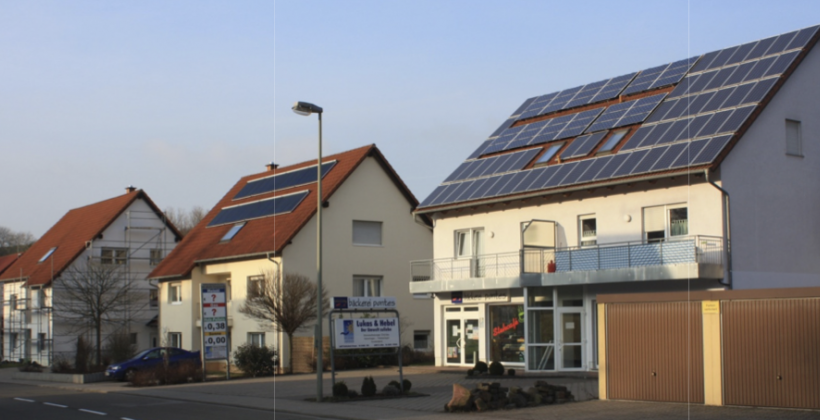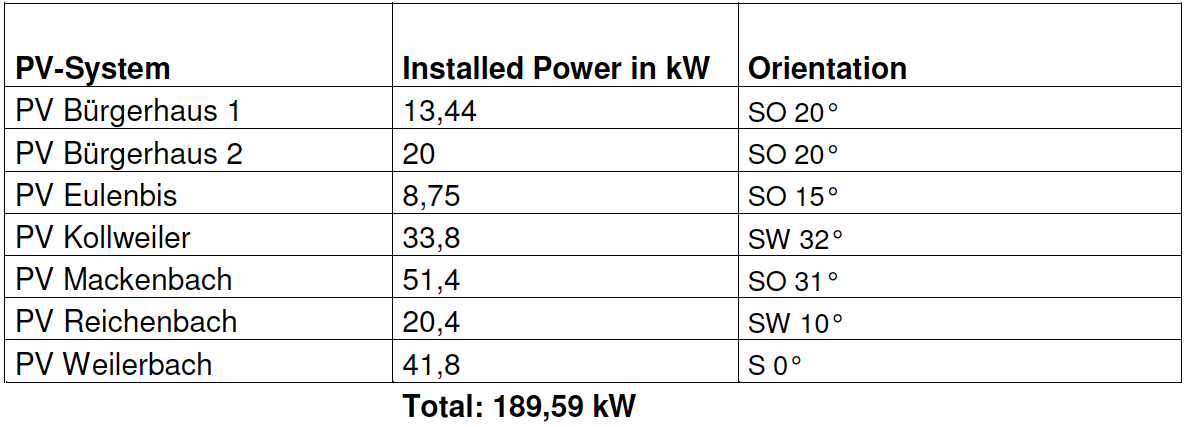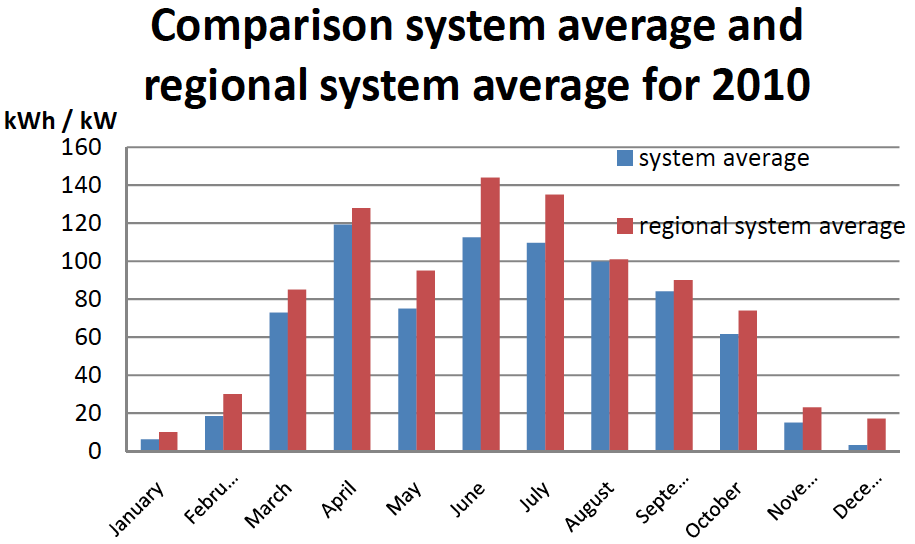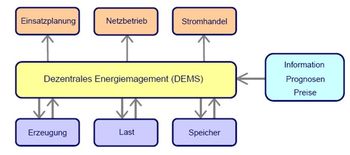
Location
Description
The association of municipalities Weilerbach is located close to Kaiserslautern in western Germany. It is a rural area – the district covers eight villages from Reichenbach-Steegen in the West to Rodenbach in the East. Weilerbach´s aim is to become a zero emission village by achieving CO2 neutrality by 2015.
Picture 1 - Small scale district heating network in Reichenbach-Steegen Picture 2 – Straw Bale House without and with outside plaster Picture 3 - Aerial view of photovoltaic plant Picture 4 – The small heating central for the DHS at Reichenbach main street icture 5 – Pellet suction device for the boiler supply Picture 6 - Ground-based photovoltaic plant Picture 7 – The PV systems at the “Bürherhaus” Picture 8 - The INES (IZES node for external systems)-box
Documents
Site facts and figures
- Estimated population involved: 18,000
- Approx. geographical area coverage: Information will follow
- Approx. energy saving: 10 %
- Approx. energy from RES: 100 %
Technologies
Technologymix
Within the residential sector 80 energy efficient houses have been built and 50 biomass boilers (in total 826 kW) and 124 solar thermal systems (in total 890 kW) have been installed. Two solar air collector systems have been installed, which heat up the supply air of mechanical ventilation systems. Furthermore four small district-heating networks, based on biomass and connecting up to four buildings, have been implemented (Picture 1).
A very special house has been constructed in Weilerbach-Eulenbis: a plus energy straw-bale house. The walls are constructed out of pressed straw bales and achieve high insulation values (Picture 2). The straw-bale building and a 3-family-house are connected to a small district-heating network, which is supplied by solar collectors and a piece wood boiler. The output heat of the collectors can be stored to three storages: 50 m³ concrete, ground underneath the straw bale house and a 5,000 litre water storage tank.
One outstanding project at Weilerbach is a photovoltaic plant, which has 1.1 MW peak power, a module area of about 12,000 m² and is supposed to save 578 t of CO2 per year (Picture 3). The plant is in operation since the end of 2010 and is supposed to provide 1.13 million kWh per year, equal to the electricity consumption of about 300 households. CONCERTO funding was only used for the organization and coordination of stakeholders, the financing was realized as a citizen share model.
The modernization of street lamps had been planned by the local ESCO (“Pfalzwerke”) for seven villages and is completed in five villages so far: Erzenhausen, Eulenbis, Schwedelbach, Rodenbach, Weilerbach. The community Reichenbach-Steegen intends to implement LED lamps and three sample lamps had been already installed for testing in a chosen street. These measures are estimated to save 21% of electricity compared to the year 2007.
In the field of E-Mobility a lot of dissemination actions had been performed by Weilerbach. The purchased pedelecs (e-bikes) are on the one hand used for the administrative staff as company vehicles and permanently exhibited in the entrance hall of the community administration, on the other hand available to citizens and tourists during public events and fairs (Picture 4). Two e-bikes are owned by a hotel and can be rented by tourists.
Dealing with the matching of demand and supply is the so-called DEMS® (decentralized energy management system), which is part of the SEMS-sites Weilerbach, Tulln und Redange. The research is located at the IZES institute and in Weilerbach 40 facilities have been integrated into DEMS. The company “CEMO” (meat market) was monitored as a sample large consumer in the DEMS tool.
A wind power plant of 4.5 MW had been planned to be constructed, but could not be installed yet due to permission problems. However, the permission for one plant with 2.3 MW power has finally been given and the turbine will be installed shortly after the end of the SEMS period.
District Heating Networks
Four small district heating networks based on biomass have been realized within the CONCERTO project period. One of them is located at the main street in Reichenbach connects three buildings (residential and commercial use) summing up to 9 dwellings. A pellet boiler with 50 kW (Picture 4) and a 32 m² thermal collector system supply the heat to the network, additionally a PV system was installed on the roof of one building. The storage for the pellets has been built in the attic of one house (Picture 5) and its filling is realized by blowing in the pellets from the truck. The total heated area is 936 m², 17 people live in the houses, 3 to 8 people work in the office and altogether 9 gas boilers have been replaced.
At the end of the project four further district heating projects could be initiated, but not finished within the funding period.
Photovoltaics
The 15,814 photovoltaic thin film modules of the solar plant are ground-based and installed at agricultural land (Picture 6). The installation site is 4.2 ha, the modules altogether sum to an area of 11,683 m², resulting in a peak power of 1.089 kW and a predicted output of 1.13 million kWh per year. This is supposed to save 578 t of CO2 per year. The plant was commissioned at December, 31st 2010. The financing has been realized to 100% by the citizens, whereas citizen of the Weilerbach region had a pre-emption right.
Evaluation of the large scale PV has not yet been possible, but six of the small Evaluation of the large scale PV had not been possible until the end of the project, but six of the small-scale systems with a total peak power of 190 kW have been monitored. Table 1 shows the details, the systems at “Bürgerhaus” (Picture 7) are regarded as one system due to one common electric meter. In Diagram 1 the performance of the systems in 2010 is shown. It is shown, that the systems slightly lag behind the regional averaged output values. These regional reference values are calculated by Meteomedia, which is one of the largest German providers of weather data. Within the SEMS project it acts as a meteorological consultant and provides the project with the forecast and measurement data. The reason for the difference in output energy is the fact that the six photovoltaic systems are not all perfectly orientated, as existing roof surfaces were used for their installation.

Table 1 – Figures on small scale photovoltaics

Diagram 1 – Monthly specific output energy per installed peak power in 2010
Energy Management
The decentralized energy management system (DEMS®) aims to a 100% supply by renewable energies on the community level by managing supply, demand and storing. Predictions based on historical experience and weather data as well as real-time monitoring and control are supposed to grant the optimal operation of an energy grid (Diagram 2). For connecting external systems to the DEMS the IZES institute has developed the so-called INES-box (Picture 8). More information on DEMS®: http://www.siemens.at/dems/ and http://www.izes.de/cms/front_content.php?idcat=188&idart=296
Lessons learnt
The following information has been gathered as part of the CONCERTO Premium policy research.
Benefits of CONCERTO:
Key benefits:
CONCERTO made it possible to implement demonstration/ flagship projects which will encourage public awareness and replication. The SEMS action plan helped to achieve that 60% of all electricity consumed within VB Weilerbach comes from RES (Total consumption is about 60 million kWh/ yr. – about 34 million kWh will be from RES, once 2 wind turbines have been installed. The emphasize for SEMS was on energy management / “energy accountancy” using appropriate energy management systems (various sources).
Local economic effects:
EUR 47 million have been invested in total raising 7.5 million in VAT (which is shared between national Government and the federal state.
Barriers encountered:
Legal barriers:
The military administration of Ramstein airbase, which is located directly next to the community association of Weilerbach, raised objections against the planned wind turbines due to its radar system. Generally, this airbase is souvereign territory of the US Airforce, but certain administrative issues are handled by the German military administration, which makes the situation even more complex. After one year of analyzing the situation and several meetings, the military administration rejected the plan again. This decision can hardly be understood, as there are already 16 (!) existing turbines installed at this location. In December 2010 the investor received an expert assessment regarding radar measurement which clearly states that two further plants are permissible on the planned location. Further intensive talks with the military administration took place. Finally the investor achieved a mutually agreed permission for at least one wind turbine which can be installed at the earmarked location, but the second one should be shifted to a new area nearby. There were also worries that rules on protecting the red kite bird could pose a barrier, but did not turn out to be the case.
Technical barriers :
Large-scale integration of RES and EE in communities with more than some 1.000 inhabitants requires a comprehensive technical and organisational management of a large number of distributed energy generation, consumption and eventually storage units. It also requires the comprehensive involvement of a large number of individuals and different groups of society, including local companies. Certain problems with energy monitoring software and hardware (data-loggers etc.) and various interfaces arose. The Energy management systems had to use the following 3 components:
- DEMS (Decentralised Energy Management System) for technical energy management
- E(ner)MAS for organisational energy management
- MFM (Material Flow Management) for further optimising energy management
Consequently, technical issues with energy monitoring could generally be solved .
Regarding the calculation of emissions savings of fabric efficiency measures it was important to know that many people in Weilerbach have comparably large houses (ave. 200sqm), which will only be partially heated. Hence calculated energy and financial savings will not materialize, if calculations are done on the basis of heating the whole house. Therefore, Energy advice had to be tailormade, based on bills and further documentations. It was found that only insulation of lofts/ roofs, basement ceilings and of more efficient heating systems were financially viable, but not improvements to the façade. However, windows were often replaced for aesthetic reasons.
Economic barriers:
The use of vegetable Oil as transport fuel had been planned involving collaboration with farmers and setting up of a filling station. However, the price of vegetable oil was found to be too high (the crude oil prices were too low) to make this project viable. It was found that in Germany the use of plant oil in stationary as well as in transport applications is hardly possible for economic reasons. Therefore this part of the project plan could not be implemented. It was replaced by a totally different activity, namely the retrofitting of the sewage treatment plant.
Social barriers:
Certain important key players and their involvement in the preparation of the SEMS project had not been given enough attention. This was not helped by the fact, that four years had elapsed between the initial SEMS funding request and the actual start of project activities. The attention and mobilisation of the citizens that could be achieved during the preparation phase could therefore not be sustained. This turned out to be a problem during the implementation, e.g. when it came to the detailed planning of the district heating networks in Weilerbach. When setting up a RES district heating system in a rural area with woody biomass supply chain, some stakeholders are no contractual SEMS project partners. Furthermore, the mayors of the communities involved are of various political parties. Some mayors had changed in the 3 years that it took to obtain EC funding. This meant that some of the mayors involved had not been part of negotiations and did not feel they had ownership of the project. Nevertheless, the local project partners involved see the high potential of district heating and continue working toward it. One promising large scale district heating system within existing urban context is the project “Weilerbach Center”, which will be bigger than originally planned .
People fear dirt and disruptions from refurbishment works . Consequently, people preferred PV over refurbishment measures.
Administrative barriers:
Regarding the accounting for financial benefits of sustainable energy measures one issue is that several departments are responsible for the payment of the energy bills of different buildings. The greatest difficulty is to account for fuels that can be stored (wood pellets, oil). Centralizing the data means restructuring the departments - those responsible for retrofitting, payment of bills, energy procurement. The implementation of a sustainable structure is under discussion.
The project contained an activity offering pellet stoves and energy contracting for sports clubs. The sports clubs were not contractual SEMS project partners - they were external third parties. Therefore implementation could not be forced through. It can only be initiated and supported through consultancy. It turned out that due to the very specific social and organizational structures (e.g. reliance of voluntary work, low budget, decision making by the board rather than by individuals, no professional caretakers) a number of barriers arose. The table tennis hall in Erzenhausen has been equipped with a pellet oven. The major reason, why this implementation was successful, is that the mayor of Erzenhausen was fully committed to this retrofitting process. He made several dates with SMEs and convinced everybody. The other sports clubs did not have similarly supportive individuals. Over all, only 2 of the 5 biomass boilers planned could be achieved, but other energy savings measures were implemented, which were considered more urgent and appropriate. Hence comparable energy/ CO2 saving should be achieved overall.
Success factors identified:
Technical success Factors:
The CONCERTO programme obliged the SEMS core regions to undertake comprehensive monitoring and evaluation of their processes, which was key to their success.
Social success factors:
Intensive consultation: The intensive consultation activities of the so-called energy change managers and the various communication activities were very successful in promoting uptake of relatively inexpensive measures such as installations of solar-thermal collectors, biomass heating systems, energy-saving heating pumps, etc.. It was very important that the energy change manager was employed by the municipality on the same terms and conditions as their colleagues. This helped them and their expertise to be accepted and respected by colleagues and also made access to Data easier. In Weilerbach 1.5 FTE post were created. The communication activities that were developed by the SEMS core regions provide a rich portfolio of innovative approaches to communication withiin energy regions, which can be taken on by other regions.
The great success of installing an SEMS Energy Change Manager: more than 928 consultations of citizens took place by phone, in the office or via email, regarding EE and RES measures. Subsequent to this, intensive consultations of 240 of these citizens took place, which looked at plans, photos, bills and details of construction. The individual relationship of citizens and the SEMS helpdesk has proven to have a remarkable impact for the whole project. Addressing pivotal individuals: For example, the flat of a caretaker was refurbished to almost passive-haus standard. This convinced him of the value of energy efficiency improvements and he has become a strong supporter of the SEMS activities, helping to implement measures in the school he is looking after. Pivotal people need to show personal integrity and act as role models: the mayor of VB Weilerbach moves around on an E-bike, one of the mayors of the villages involved has a passive house, and another one is an energy advisor.
The concept “citizens inform citizens”: The (new) action enables direct contact between people who have finished their retrofitting and those who want to start theirs, include: “regular’s table”, talks, best practice examples in the regional newspaper, exchange of experiences concerning specific constructors, etc.. The “regular’s table” is a highly innovative approach of informing community members. It takes place in an informal environment and members are encouraged to discuss specific topic, e.g. RES, EE, etc.. Such an informal, direct approach has resulted in significant impact .
Institutional success factors:
The project adhered to a well-defined framework designed for regional energy transition initiatives, which had been developed under the preceding project “100RENET”. 100RENET defined 6 steps: preparation, regional analysis, definition of targets, regional action programme, implementation of measures and projects, monitoring and evaluation (with several iterations of steps 4-6). It also defines the following entities that play pivotal roles in the transition process: the energy change manager (in Weilerbach), a political process manager: the mayor and an organization for economic operations. This framework has stood the test of time and can be recommended to others. The local coordination office was very important in Weilerbach, but no organization for economic operations was set up as such (partnering organisation were used instead). In addition, the following was important: a multi-level support network at regional level in Weilerbach, which links players at different administrative and political levels (the association of communities, the district, the “Land”). The multi-level support network allows achieving a better efficiency in the implementation of various tasks in the frame of the energy change and it can replace a regional non-profit support network.
Economic success factors:
The role of the Energy Change Managers (ECMs) was crucial with its responsibility for information and communication activities developing subsidy programmes and coordination of local project activities in the core communities with the local partners. Also, the peak in energy prices in 2008 helped to persuade more people to retrofit EE-measures to their existing houses.
Other success factors:
A series of similarly focused projects built upon each other to gradually move the region closer to the ideal of 100% RE, starting with “ZEV” (Zero emission Village) in 2001, which identified a strategy of 10% reduction in consumption, 40% reduction in heating energy consumption and full use of locally available renewable energy potential. SEMS could build on this existing strategy. Other Projects supporting the same aims were RECORA and 100RENET, and an energy audit of municipal buildings as part of participation in the “Klimaschutzinitiative in Germany”. Weilerbach had previous experience in working with SEMS partner Tulln on the aforementioned ”RECORA”.
Business models used:
A contracting offers had been developed, but isn’t requested very often (SEMS fund at Pfalzwerke, a local utility company for contractors or SME or private people). The client makes enters a contractual agreement with Pfalzwerke, makes fixed monthly payments and Pfalzwerke retains ownership of the installation (e.g. a heat pump). It is also possible for contractors (even other SME) or private people to apply for aid money out of the SEMS fund at PFALZWERKE. Only 12 of 181 house owners, that applied for retrofitting subsidies, installed a heat pump in the region . Due to low flow temperatures, in existing buildings major retrofitting measures have to be done in advance. The heat pump systems are typically either paid for from savings or with a normal bank loan. So people see no need for micro-contracting. In order to make use of the SEMS fund for contracting, new ways had to be found. Craftspeople play a multiplier role: In order to avoid failures caused by incomprehension or competitiveness amongst craftspeople, tailormade information was provided, in particular also on micro-contracting solutions. Two crafts businesses have completed installations that used the Pfalzwerke contracting offer.
Legacy – follow-on projects:
Weilerbach has become well-known in energy circles and is much admired. Many communities and other institutions have been interested in SEMS and visited Weilerbach: Representatives of other German local and regional authorities, representatives from the Green Party, from a planning institute etc..“Weilerbach Center”- district heating has scope for further expansion. SEMS general: The MFM (Material Flow Management) methodology is now also being used in Elektrenai/Lithuania – one of the observer communities.
In principle SEMS activities will continue – SEMS represented the energy action plan for recent years and a comparable action plan needs to be compiled for the coming 5 years. Potential projects could include a new solar campaign and district heating to village centres. Neighbouring community Enkenbach is now recruiting a climate change officer with similar remit to an energy change manager, the nearby local community of Birkenfeld is setting up a trustfund for funding solar installations.
The CONCERTO approach
Weilerbach is putting in place a bundle of measures as part of the SEMS initiative: It will use wind power, solar power generated by collectors on citizen´s houses, and geothermal energy via heat pumps.
These renewable sources will be combined with a biomass cogeneration plant fueled by wood chips and plant oils; a local small company will collect the waste fat within the district and deliver it to the energy utility.
The overall aim in Weilerbach is to reach a net supply of 100% of energy for electricity and heat from renewable energy sources.
Highlights
SEMS Video-clip (COMIC) developed by the SEMS Project in Weilerbach:
The old story of the Three little pigs, in the age of the Climate Change, needs to be reviewed: the little pigs, Semsi, Susi and Sibbi, have to face the Energie Riese (the Energy giant) who asks for increasingly higher energy costs. But Semsi, who built a Zero Emission Home, managed to find a way to solve the problem! For an audience of both children and adults, it is a promotion of a sustainable way of living.
Click here for the version with English subtitles, click here for the version in German language, click here for the version in French.
SEMS Video-clip (Documentation) developed by the SEMS Project in Weilerbach:
Documentation in German language: "Ein Eisblock ging auf Wanderschaft" - describing the functionality of the passive house construction in the frame of the SEMS project on the site of Weilerbach.
Thematic Field
- New Building(s)
- Refurbished Building(s)

